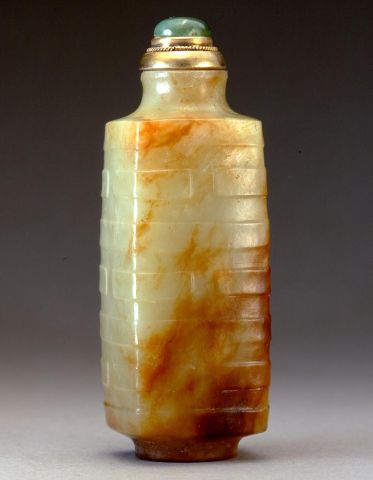
Bottle ID: 227
SQUARE CONG FORM
Date: 1736-1799
Height: 72 mm
Nephrite, greenish-yellow, of pebble material with a mottled russet brown skin and one area of crystalline markings, well hollowed, of cong form, the outer rectangular section bowed on all four sides, the inner circular element represented by the concave circular foot and the waisted, cylindrical neck; the formalized, trigramic elements of the outer surface of the cong raised and scalloped.
Probably Imperial, attributed to the Palace Workshops.
Similar Examples:
Michael C. Hughes, The Chester Beatty Library, Dublin. Chinese Snuff Bottles, 2009, p. 28-29, no. 14.
Chinese Jades: Ming Dynasty to Early Twentieth Century from the Asian Art Museum of San Francisco, 2007, p. 198, no. 215.
Provenance:
Hugh Moss [HK] Ltd.
The Imperial designation here, albeit far from proven, is based upon the taste of the Qianlong Emperor for this type of yellow jade, for pebble material, and in particular for archaistic forms and decoration, his preference for which is well recorded. The combination found here would have been perfectly in accordance with the Emperor’s taste, although it must also be allowed that it might have been a present for him, of which he received thousands during his reign, or, indeed, something made for a courtier out to impress the Emperor, or someone responding to the fashion he no doubt set at the Court.
The cong was the ancient symbol of heaven and earth, the circle representing the first and the square the second. It is a form found in archaic jades from the Neolithic to the end of the Han Period, the later versions of which are frequently decorated with trigram-like relief. The artistry of this bottle is extraordinary, although subtly expressed.
The gentle bulging of the sides of the cong are masterly, as is the technical detailing of the relief bands, each of which is gently scalloped. Both are subtle features, which transform an ordinary, and well-established form into a sculptural masterpiece.
There is another possible reference here, which if intentional, is another indication of the masterly nature of the art of this bottle. A good deal of early burial jade was of a type with plates, or crystal of chatoyant material in heavily flawed nephrite and this would have been apparent to anyone who had seen a collection of early jades, particularly cong and bi discs form the Neolithic to the early Han (than which at the time this bottle was made there was none larger than that of the Emperor). This is a much rarer feature of later nephrite material from Turkestan and it is likely that the appearance of such crystalline effects in one area of this specimen (on the bottle, high on one side, running into the shoulder and visible when the material is turned in the light) prompted the reference to the archaic form.
< Back to full list

 English
English 中文
中文